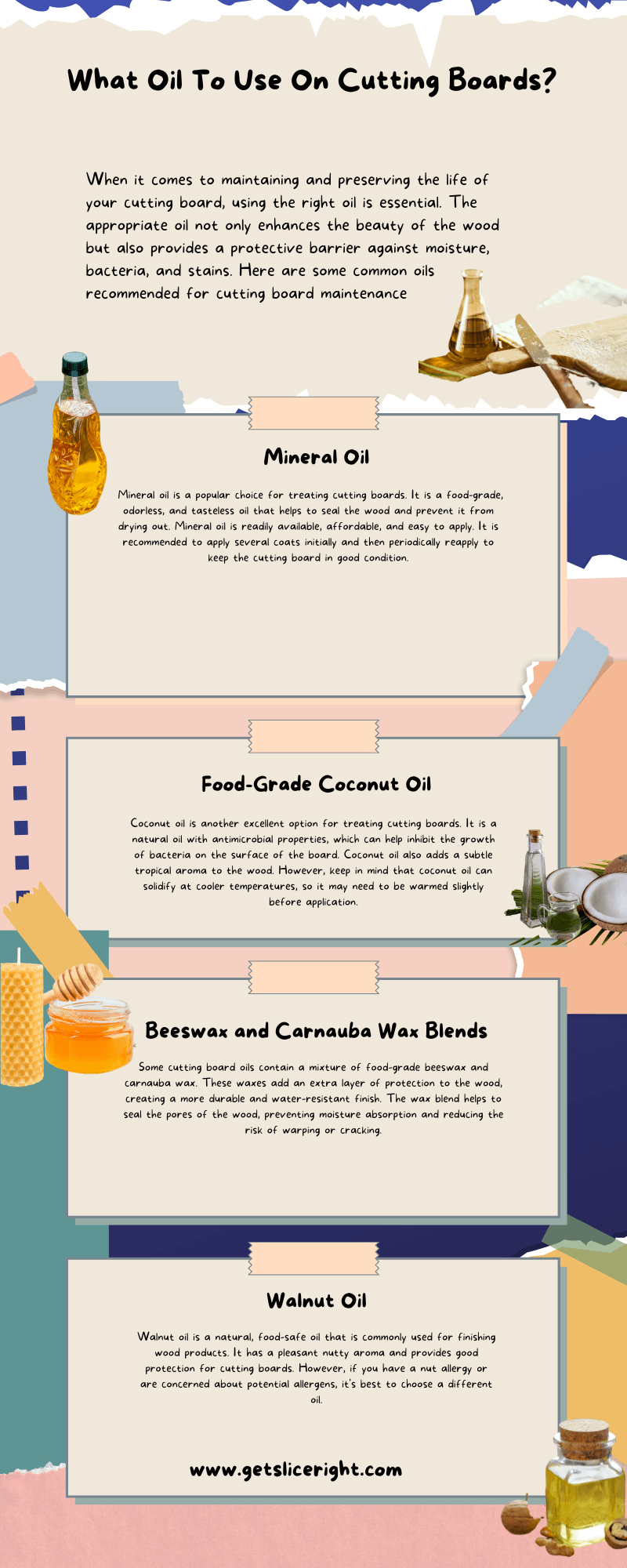Maintaining your cutting board properly can greatly extend its lifespan, and one important aspect of that maintenance is the use of oil. Oiling your cutting board serves two main purposes: it helps prevent the absorption of food odors and liquids and keeps the wood from drying out and cracking. The best oils to use are food-grade mineral oils, but other plant-based oils such as coconut oil (fractionated), beeswax, or carnauba wax are also commonly used. Avoid cooking oils like olive or vegetable oils, which can go rancid. Always choose oils that are safe for food contact to ensure the safety and longevity of your cutting board.
Should You Oil Cutting Boards?[/su_heading]
Yes, you should oil your cutting boards. Applying oil to your cutting board provides numerous benefits. It creates a protective barrier on the wood’s surface that helps repel liquids and prevents the absorption of odors and bacteria. Regularly oiling your cutting board also prevents the wood from drying out and cracking over time, which can significantly extend the life of your cutting board. However, it’s important to use the right kind of oil, food-grade mineral oil is recommended because it doesn’t turn rancid like many cooking oils. Properly caring for and maintaining your cutting board with oil ensure its longevity and safety in your kitchen.
What Oil To Use On Cutting Boards?
When it comes to choosing oils for your cutting boards, here are some recommendations:
- Food-Grade Mineral Oil: This is the most commonly used oil for cutting boards because it’s safe for food contact, affordable, and easy to find.
- Beeswax: Often combined with mineral oil, beeswax provides a nice sheen and water-resistant properties. Beeswax also brings out the rich color of the wood.
- Carnauba Wax: Another wax option, carnauba is plant-based and has a higher melting point than beeswax, making it a durable choice.
- Coconut Oil (Fractionated): Fractionated coconut oil has removed its long-chain fatty acids, preventing it from going rancid. It’s a safe alternative if you prefer a plant-based oil.
- Walnut Oil: Another plant-based oil, walnut oil is a good choice if you’re not allergic to nuts. It dries and polymerizes to create a hard, protective layer.
- Tung Oil: Derived from the nuts of the tung tree, tung oil is another option. However, pure tung oil takes time to cure and may not be suitable for all cutting boards.
Avoid using cooking oils like olive, vegetable, or canola on your cutting boards because they can oxidize and turn rancid, potentially causing unpleasant smells and flavors.
How To Oil Your Cutting Board?
Step 1: Clean the Cutting Board: Wash your cutting board thoroughly with warm soapy water. Remove all food residue and stains. Rinse and dry it completely.
Step 2: Apply the Oil: Using a clean cloth or paper towel, apply the oil of your choice to the board. Make sure to apply the oil evenly across the surface. You should also oil the sides and bottom of the board.
Step 3: Let the Oil Soak: Allow the oil to soak into the wood. Depending on the type of wood and its dryness, this can take a few minutes to several hours. For very dry boards, you might want to let it soak overnight.
Step 4: Remove Excess Oil: After the oil has had time to soak in, wipe off any excess oil with a clean, dry cloth or paper towel.
Step 5: Reapply as Necessary: Depending on how frequently you use your cutting board, you may need to re-oil it weekly, monthly, or every few months. When the board looks dry or worn, it’s time to apply more oil.
By following these steps, you’ll help extend the lifespan of your cutting board and keep it in the best possible condition.
FAQs
How often should I oil my cutting board?
Once a month is usually sufficient.
What should I do if my cutting board smells bad?
Clean it thoroughly, let it dry, and then oil it.
Can I oil a bamboo cutting board?
Yes, bamboo cutting boards benefit greatly from oiling.
What happens if I don’t oil my cutting board?
It could crack, split, or harbor bacteria.
Conclusion

Maintaining your cutting board involves the important step of oiling it regularly. The right oil can create a protective barrier, preventing the wood from absorbing odors and bacteria and keeping the wood from drying out and cracking. The best oils to use for this purpose are food-grade mineral oils. Alternatively, you can use plant-based oils like fractionated coconut oil or waxes like beeswax or carnauba wax. It’s important to avoid using cooking oils, as they can turn rancid over time. By choosing the right oil and regularly maintaining your cutting board, you will ensure its longevity and optimal performance in your kitchen.

Mario Batali is a renowned author, food enthusiast, and passionate chef who has dedicated his life to exploring the world of culinary arts. With a love for sharing his knowledge and experiences, Mario has become a prominent figure in the food blogging community, inspiring countless readers with his creativity and expertise.
In addition to his culinary prowess, Mario Batali is also a talented writer with a flair for engaging storytelling. He launched his own food blog to share his recipes, cooking tips, and personal experiences in the kitchen. Over time, Mario’s blog gained a loyal following of food enthusiasts who appreciate his unique approach to cooking and his dedication to using only the finest ingredients.
Mario Batali’s passion for food and his commitment to sharing his knowledge with others have made him a true inspiration in the world of culinary arts. Through his blog, cookbooks, and public appearances, Mario continues to spread his love of food and the joy of cooking with his ever-growing fanbase.







